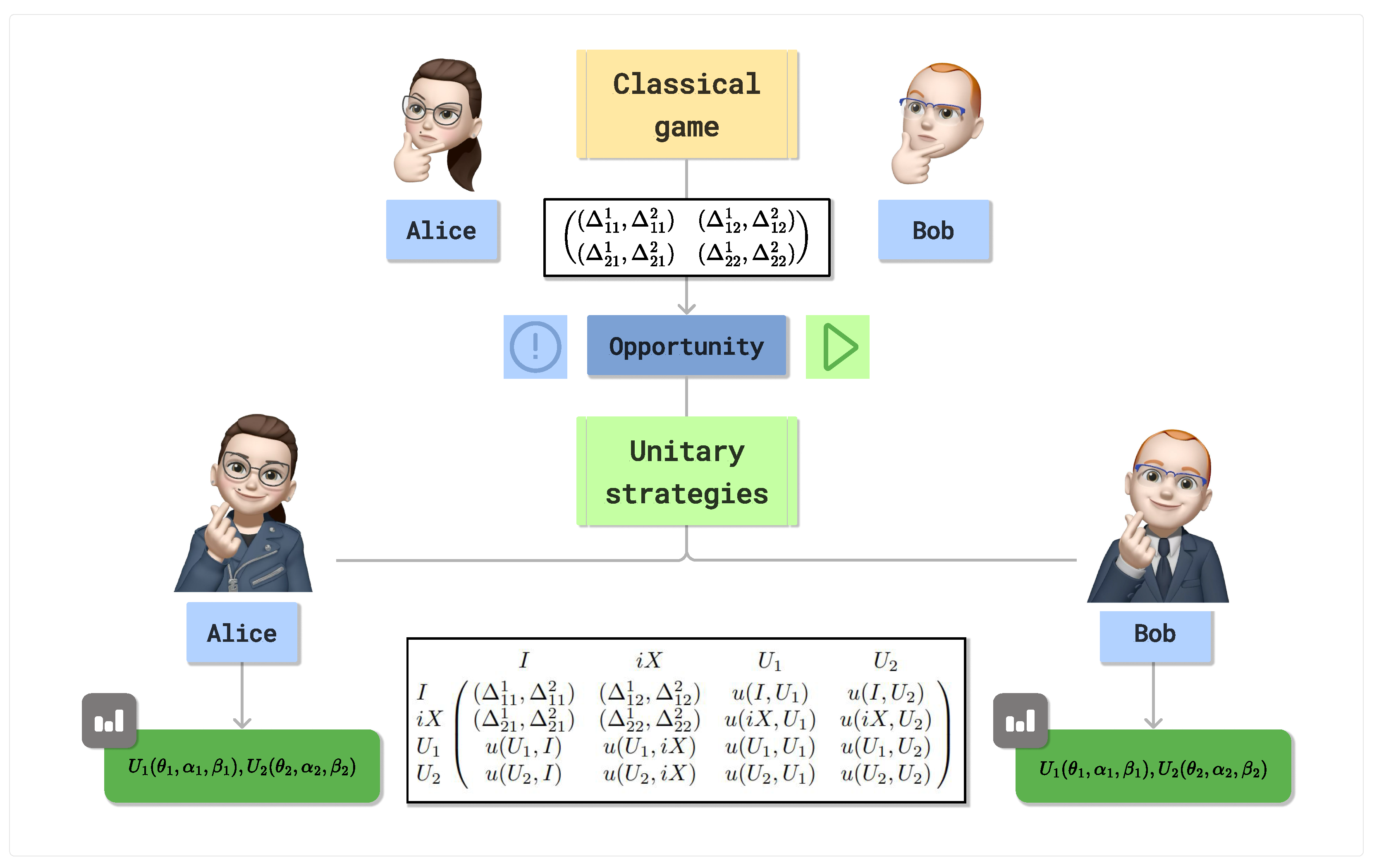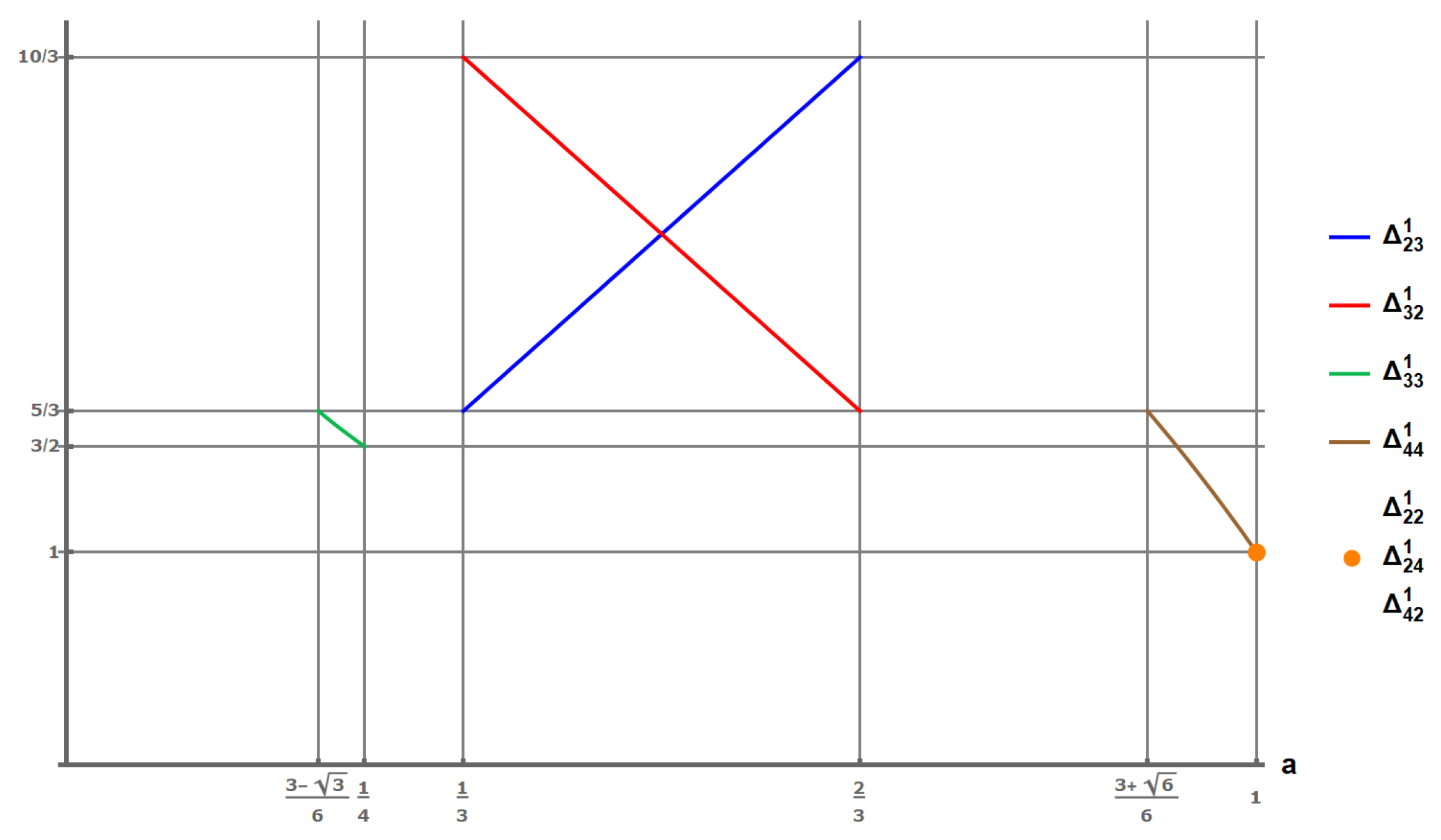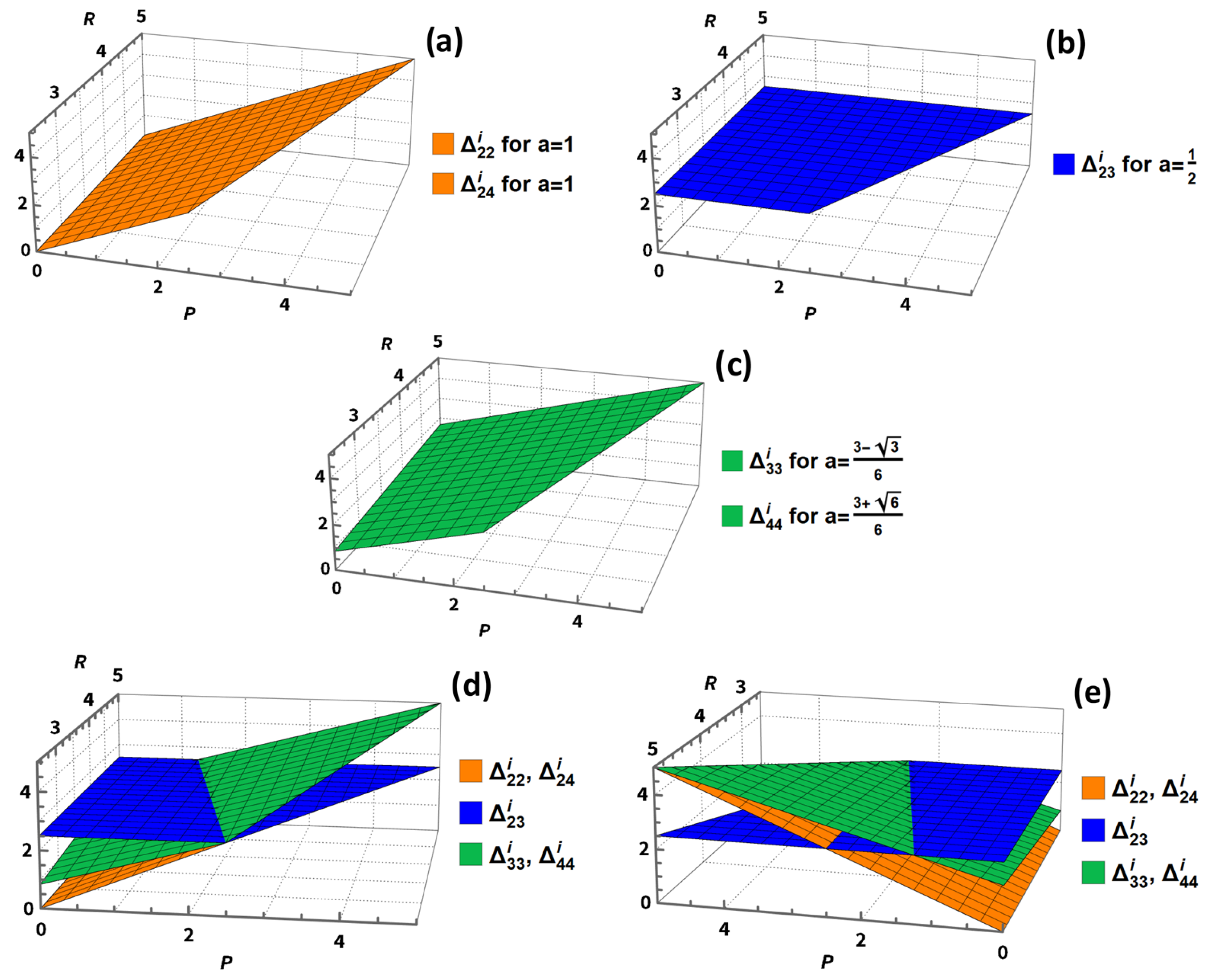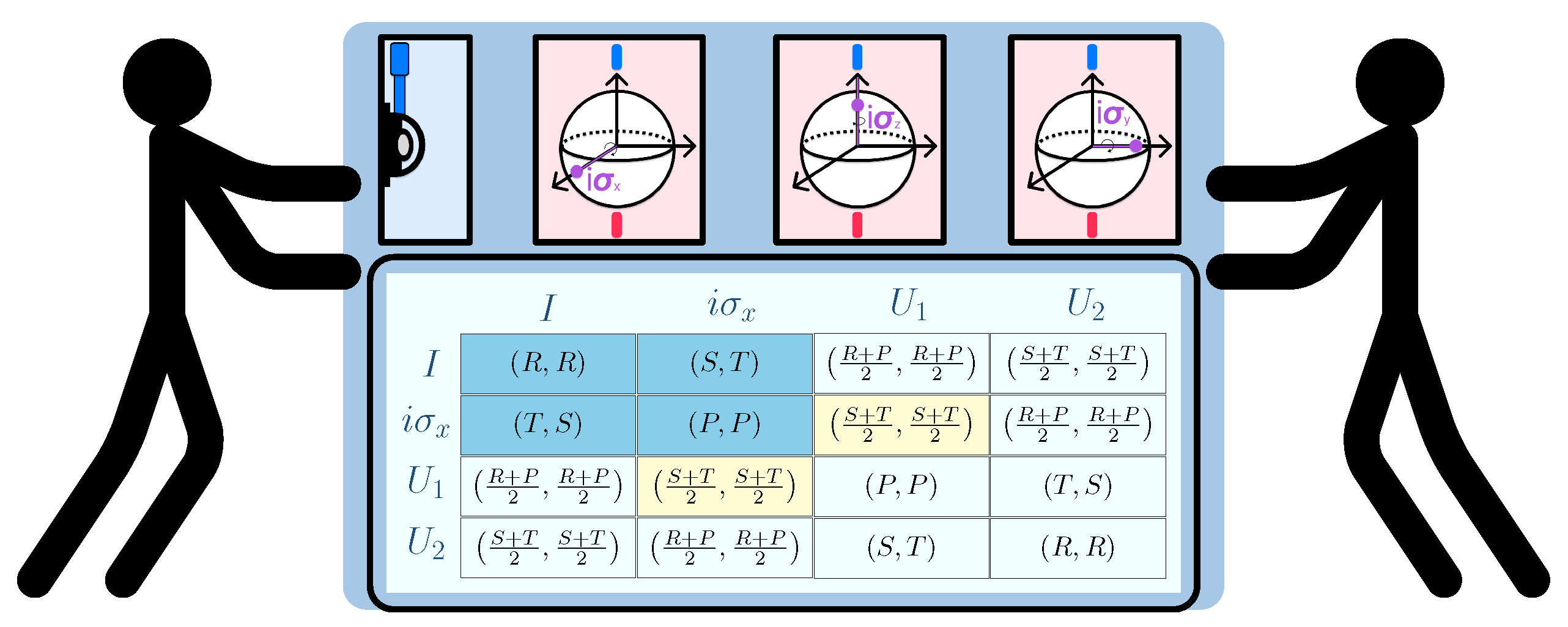1. Introduction
The main aim of quantum game theory is to establish a method for converting problems from classical game theory into a quantum mechanical context, as explored in works such as [
1,
2,
3,
4]. The features of the transformed game are then examined employing classical game theory techniques [
5,
6,
7,
8]. Alternatively, the quantum game is analyzed using principles from quantum computing [
9,
10,
11,
12]. Recent studies also demonstrate the growing practical relevance of quantum games, with experimental and theoretical work showing quantum advantages in settings such as the Magic Square game, quantum duopolies, and multiplayer strategy games [
13,
14,
15,
16,
17]. In quantum game theory, akin to classical game theory, the primary issue studied is the identification of rational strategy profiles and assessing the impact of the game’s quantum extension on the ultimate outcome. In [
18], the authors investigate how the dynamic behavior of the Nash equilibrium search process is affected by different unitary operators. Reference [
19] demonstrates how the structure of Nash equilibria varies with different quantization approaches. Reference [
20] explores the relationship between the payoffs resulting from Nash equilibria in classical and quantum games, and those arising from correlated equilibrium. In the case where players are allowed to use the full set of unitary strategies, pure-strategy Nash equilibria typically do not exist. An analysis of best responses reveals that for any given pure strategy, there exists a counter-strategy that provides the opponent with a strictly better payoff [
21,
22]. In this framework, the Nash equilibrium (NE) stands out as a significant solution concept [
23], considered vital for assessing the rationality of a particular strategy profile. An NE is defined as a strategy profile where no individual can improve their payoff by changing their strategy alone, assuming the strategies of others remain unchanged. This concept is relevant due to its formulation for both classical and quantum games.
The Prisoner’s Dilemma (PD) represents a traditional issue in game theory, showcasing the tension between personal rational actions and group well-being [
24]. Conventionally, the PD game involves two participants, each with a binary choice between cooperating and defecting. In its typical form, the PD game possesses a unique NE where both participants opt to defect, resulting in a less favorable outcome for each. Conversely, the incorporation of quantum strategies presents opportunities to modify this equilibrium framework, which may enable more advantageous results for all participants [
1,
25,
26].
In our earlier studies [
27,
28], we explored the quantum extension of classical games by employing the Eisert–Wilkens–Lewenstein (EWL) framework [
1], wherein we enhanced the classical strategies with additional unitary strategies. Quantum extensions have been categorized into several distinct groups, according to the features of allowable quantum strategies that maintain invariance under isomorphic transformations of the classical game. Our main objective was to pinpoint the conditions that ensure these quantum games retain the structural properties of the original, while broadening the strategic options for the players.
The main objective of this research is to conduct an in-depth examination of these extensions by identifying each NE within the pure strategy profiles of the quantum-enhanced PD. By investigating the PD in its broadest form and assessing any allowable set of payoffs, the study aims to establish the conditions required to achieve an NE for each type of extension. In particular, this work evaluates the requirements the payoff matrix must meet for a particular pure strategy profile to qualify as an NE across all identified categories of quantum extensions.
This thorough analysis offers a detailed characterization of strategic profiles and their associated NE, thus advancing the understanding of the influence of quantum strategies on conventional game-theoretical issues. The study shows that the NE derived are more aligned with Pareto-optimal solutions compared to the traditional PD. At this point, it is important to note that the extensions considered do not include completely cooperative equilibria. Pareto-optimal Nash equilibria were obtained through the quantization of classical games according to the EWL scheme [
1]. However, they fail to meet the criterion of independence from isomorphic transformations of the classical game and, in our opinion, do not represent an acceptable extension of the classical game [
28]. This independence is essential to ensure that the process of quantizing a classical game is unambiguous, which we consider a necessary condition for referring to it as an extension. This paper contributes to not only advancing the theoretical foundations of quantum game theory but also has potential implications for areas like quantum computing and strategic decision-making [
6,
29], where comprehending intricate interactive dynamics is essential.
The paper is organized into five sections. The
Section 2 provides definitions of key concepts such as PD, NE, and the EWL quantum game framework. It also shows that positive affine transformations of classical game payoffs do not change the preference relations in the quantum game. In
Section 3,we revisit five categories of quantum extensions for the classical
game. In these extensions, quantum players are provided with two more unitary strategies besides their original classical strategies. These extensions remain invariant under isomorphic transformations of the classical game [
28]. Additionally, we illustrate the symmetry present in quantum extensions of the symmetric game. In
Section 4, which is split into five sub-sections, we explore the existence of NE across successive classes of extensions. This involves analyzing each of the 16 potential strategy profiles of pure strategies.
Appendix A,
Appendix B,
Appendix C,
Appendix D and
Appendix E of the paper contain the proofs for the propositions discussed in this section. For existing equilibria, we present the requisite conditions for the parameters of quantum strategies and PD payoffs that must be met.
2. Preliminaries
To ground the analysis in the established theory, we first present a set of definitions and propositions related to further discussion of the existence of NE. This study then aims to systematically identify all pure NE in permissible quantum extensions of the Prisoner’s Dilemma. By analyzing the game throughout a full range of payoff configurations, it establishes the conditions under which each extension admits an NE. Special focus is given to the payoff matrix requirements for a strategy profile to qualify as an equilibrium in each case.
In our research, we examine strategic form games, encompassing both traditional classical games and quantum games. A game in strategic (normal) form is formally defined as follows [
30]:
Definition 1. A game in strategic form is a triple in which
is a finite set of players;
is the set of strategies of player i, for each player ;
is a function that relates each vector of strategies to the payoff of the player i, for each player .
A strategic-form finite game involving two players can be represented by a bimatrix:
The interpretation of such a notation is that player 1 (the row player) chooses row
from his set of strategies
, and player 2 (the column player) chooses column
from her set
. The combination of player 1 using strategy
i and player 2 using strategy
j will be represented as the ordered pair
and referred to as a strategy profile. As the result of the game, player 1 receives payoff
and player 2 receives
. Taking into account the elements that define a game in strategic form, we can identify the payoff function of (
1) as matrices
and
and denote the game (
1) as
.
Among the games represented by (
1), we can distinguish those that have certain special characteristics. Symmetric games serve as an example of these [
31].
Definition 2. Let be a two-player finite strategic game. is said to be symmetric if and for all .
In matrix notation, the fact that a game
is symmetric means that
. One of the best-known symmetric games is the PD. It is a two-player game that can be represented by a
bimatrix in the form of
In the field of game theory, the notion of NE plays a key role as a fundamental solution concept [
32]. This equilibrium represents a strategy profile such that no player can gain a better payoff by deviating from her equilibrium strategy, provided that the other players’ strategies remain unchanged. NE provides players with a certain level of stability within a game as in an NE, each player’s strategy is a best response to the strategies of the other players.
The literature offers numerous approaches to define NE based on the specific game type under consideration [
30,
33]. Herein, we articulate NE as they pertain to the games studied in this research, with particular emphasis on pure NE in bimatrix games.
Definition 3. A strategy profile is a (pure) NE if for every and for every .
As an illustration, it can be readily confirmed that the unique NE in (
2) is the strategy profile
, which results in each player receiving a payoff of
P (
Figure 1). This equilibrium of the classical game is not Pareto-optimal, and this leads to a series of suboptimal decisions in human interactions [
34]. The lack of Pareto optimality of the NE of the PD illustrates the conflict between maximizing individual payoffs (a rational strategy in the sense of game theory) and maximizing aggregate welfare (a Pareto-optimal solution). This phenomenon can be seen in many everyday and economic problems, such as pollution, the use of common resources, or lack of cooperation in business without proper contract enforcement mechanisms [
35].
From Definition 2, it can be deduced that there is a symmetry of the set of NE of a two-player symmetric game: if
is an NE, then
is also an NE. Now, we review the Eisert–Wilkens–Lewenstein scheme for
bimatrix games [
2].
Definition 4. The Eisert–Wilkens–Lewenstein quantization of the game given by (1) for is defined by the triple , where The EWL quantization scheme is represented schematically in
Figure 2.
Using Formula (
6) we can determine the explicit form of the pair of players’ payoffs,
A classical
game is a strategic interaction between two players, each of whom selects one of two available strategies. The outcomes of these interactions are represented in a bimatrix, where each cell denotes the corresponding payoffs to both players based on their chosen strategies.
Figure 3 presents a conceptual diagram illustrating how a classical game can be extended by enabling players to adopt a broader range of strategies, specifically, two unitary strategies.
Although players use all strategies in a classical manner, the quantum extensions enrich the strategic space. Even without recognizing their quantum origin, players can leverage these new options to form strategies that outperform those in the original game. It is important to emphasize that it can lead to NE that are closer to Pareto-optimal outcomes than those achievable in the purely classical setting.
In this study, we intend to utilize significant elements of John von Neumann’s utility theory. This theoretical framework offers a mechanism for classifying games. The payoff functions of all games within a class determine the same preference relations of the players. Hence, for any opponent’s strategy, the player’s optimal response remains consistent across all games within the class, making the games equivalent with respect to NE.
Definition 5 ([
30])
. Let be a function. A function is a positive affine transformation of u if there exists a positive real number and a real number μ such that A special case of von Neumann’s linear utility function theorem is
Theorem 1. If is a payoff function representing player i-th preference relation, then any positive affine transformation of is a payoff function representing the same preference relation.
Let us consider a general PD game given by (
2). Let us define a positive affine transformation of the form
This transformation permits the payoffs of the general form of PD (
2) to be reduced to two parameters,
r and
p, with values in the interval
:
and
. As a result, we obtain a game
which is equivalent to game (
2) with respect to preference relations. In other words, they represent the same problem from a game theory point of view. Taking into account (
10)–(
13) and (
14) one can therefore consider a general PD game as
Example 1. A commonly used bimatrix of the PDis equivalent to game (15), where and . In the remainder of this paper, we investigate NE by proving theorems about the conditions for their existence for the general form of the PD given in (
15). However, for purposes of clarity, selected examples of equilibria will be presented in the context of its common form (
16).
The application of a positive affine transformation in the classical game does not also affect the EWL quantization of the game.
Proposition 1. The payoffs’ preference relations of the EWL scheme are invariant with respect to a positive affine transformation of payoffs in the classical game.
Proof. Let us consider a positive affine transformation
and a pair of bimatrix games of the form
Let
be a strategy profile that is more preferred by player
i than a profile
. Both strategy profiles determine some probability distributions
and
defined by the payoff function in the EWL scheme (
7) for
, i.e., over
, and
On the other hand, in the EWL scheme for
□
Therefore, the strategy profile
is more preferred than a profile
by player
i also in the EWL scheme of the game
. As a result of this property, any NE found for a particular EWL quantization of game (
15) will likewise serve as an equilibrium for the EWL quantization of the corresponding game (
2).
3. Permissible Four-Strategy Quantum Extensions
The study [
28] examined EWL quantizations of a
classical game by transforming it into
games, incorporating two additional unitary strategies,
and
, alongside the classical strategies
I and
. It was demonstrated that there are only five classes of such quantizations that satisfy the invariance condition with respect to isomorphisms of the classical game. Such quantizations are referred to as
extensions of the classical game. Each of the classical game extension classes below corresponds to the specific parameters
,
of the unitary operators
,
of the extension. Since the focus of this paper is on NE, in the following, we will only give selected strategy parameters, e.g., those on which the payoffs of a quantum game depend. Further details regarding the remaining parameters of the strategy can be found in Table 1 of the article [
28].
As demonstrated in the aforementioned paper, all four-strategy quantum extensions of the classical game defined by (
15) can be expressed by the
matrix itself and three derivative matrices:
derived from (
15), by swapping rows, columns, or both.
The first extension class
A is defined by matrices
where
,
and
,
. Other parameters of quantum strategies are defined in [
28], in particular
and
for
and vice versa for
. The second class of extensions
B, where
, is characterized by the matrix
Extension of the class
C is given by the formula
where
,
. For class
C, as well as for classes
D and
E,
. The class
D can be determined by the following matrices:
The last class
E is determined by the matrices
The analysis of NE will be simplified by the symmetry of the extension matrix. Consequently, we will prove the following theorem.
Proposition 2. If a two-player game Γ is symmetric, then its quantum EWL extension is also a symmetric game.
Proof. First note that
in Formula (
6) for each pair
. Moreover, if a bimatrix game
is symmetric then
. Then, it follows that
□
Based on Proposition 2, the following conclusion can be drawn:
Corollary 1. If a two-player game Γ is symmetric, then all extensions are also symmetric games.
Example 2. As an example, let us examine the symmetries of the Γ game (15):It is symmetric, as the players’ payoffs submatrices obey the relationIn addition, definition (20) allows us to infer thatThe symmetry of the extension matrices (21) and (22)–(25) can be attributed to the relationships given in (29) and (30). To illustrate, consider the extension : Throughout the rest of this analysis, to simplify the equations, our attention will be centered on the extension matrices of the first player. It is understood that the matrices for the second player are simply the transposed versions of these.
5. Conclusions
Quantum game theory exhibits a high level of complexity because it integrates multiple scientific domains including physics, computer science, mathematics, and economics. This interdisciplinary nature creates a significant barrier to entry for researchers interested in exploring this field. However, alongside the advancements within the realm of emerging technologies, especially quantum computing, there is a growing emphasis on comprehending their associated threats and benefits. Potential users most commonly perceive the strategic implications of quantum computing in terms of its impact on security. In addition, anticipated gains exist concerning the acceleration of calculations. Globally, various research institutions provide strategic plans that detail milestones for information security teams in preparation for impending quantum threats. Conversely, quantum key distribution offers exceptionally secure key distribution and has been evaluated through pilot projects to serve as a foundation for encrypting user data.
In a context where quantum developments are primarily seen as threats rather than new opportunities, we put forward a theory of quantum games. This approach suggests that by integrating classical and quantum strategies, players can access a range of novel possibilities for achieving their objectives. The primary objective of quantum game theory application is to enhance individual payoff, adhering to a Nash equilibrium strategy, while simultaneously improving social welfare in accordance with a Pareto-optimal solution.
Our research aimed to explore quantum extensions of the standard format of the Prisoner’s Dilemma game through the integration of two unitary strategies into its classical version [
28]. We determined all possible combinations of quantum strategies that lead to Nash equilibria in pure strategies. These equilibria are observed in all possible extension categories, with the exception of the
class. The prerequisites for the existence of the previously mentioned equilibria are generally intricate, involving several interactions between the payoffs of the traditional game and specific parameters (
and
) associated with the unitary strategies. Additionally, we examined the significance of equal payoffs in Nash equilibria for extended versions of the standard Prisoner’s Dilemma, as specified by Equation (
16). Our findings suggest that these payoffs attain a maximum value of
, thereby exhibiting a closer alignment with Pareto-optimal solutions than the conventional Nash equilibrium outcome of the Prisoner’s Dilemma, which stands at 1. Nonetheless, achieving Pareto-optimal values, specifically 3 in this context, remains unattainable.
These findings can serve as a foundational basis for further exploration of NE, which can also be expressed using mixed strategies. A compelling research direction would be to determine if such NE can be more closely aligned with Pareto-optimal solutions compared to the results derived from employing pure strategies.













